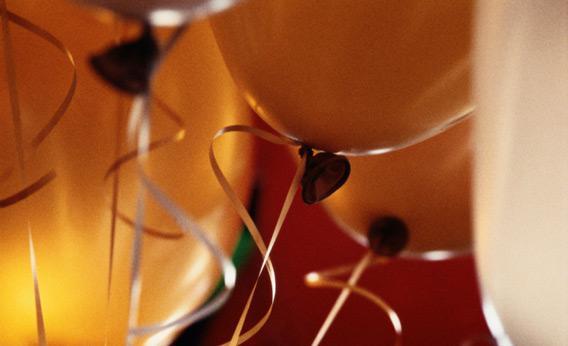Schoolchildren in Augusta, Ga. released a balloon rosary into the air Monday, in a celebration of the feast day of Our Lady of Guadalupe. On New Year’s Eve thousands of balloons will be dropped from ceilings across the country, and on Thanksgiving balloons filled the skies as part of the Macy’s Day Parade. Why do we celebrate things with balloons?
Because they’re cheap and colorful, and people like watching things fly away. Balloons in their various forms were invented for use in military communications, scientific experiments, and transportation, but it wasn’t long before people began to have fun with them. The first rubber balloons were made by Michael Faraday in 1824, for use in the laboratory. Faraday laid two sheets of rubber on top of each other, put flour in the middle to prevent them from joining all the way through, and then sealed the edges together. Faraday noted that when he filled the balloons with hydrogen they had “considerable ascending power,” though he was disappointed to find that the hydrogen kept escaping. British inventor and rubber manufacturer Thomas Hancock began distributing balloon-making kits in the following year, and by 1847, London entrepreneurs were selling the first balloons made of vulcanized rubber, allowing for a stronger, more elastic balloon. It wasn’t long before the idea had been exploited for use at parties: According to an 1873 New York Times article on the balloon’s potential industrial applications, it “may be made of vast use” for meteorologists and military men “and will always be an interesting addition to the amusements of popular gatherings.”
Rubber balloons weren’t manufactured in the United States until 1907, but their popularity appears to have increased throughout most of the 20th century. The first commercial sausage balloons were produced in 1912, and Americans began twisting balloons to make animals in the late-1930s or early-1940s. Another boom in recreational balloon use occurred with the introduction of foil balloons in the 1970s. Foil balloons hold their shape better than rubber balloons, and so they were better for conveying messages like “Happy birthday!” or “It’s a boy!”
Rubber and foil balloons aren’t the only kinds used for celebrations. In East Asia, sky lanterns—a form of hot-air balloon made by lighting a small flame inside a paper lantern—have been popular for many centuries. They were initially used for military signaling, but now are launched by the hundreds as a form of celebration at many festivals. (They’re also a known fire hazard, and have been banned in some countries.) For other skyward spectacles, people have shot off fireworks and released birds.
Fears of damaging the environment have cut into balloon sales in recent years. The Balloon Council says that a properly functioning latex balloon freezes when it reaches an altitude of about five miles, breaks into slivers that look like spaghetti, and breaks down in the soil like a leaf. Indeed, natural latex is biodegradable, but most rubber balloons are made of chemical-treated latex and may last for months. Balloons can be dangerous to sea animals including porpoises, turtles, dolphins, and whales, as they can become lodged in the animal’s digestive tract (which could lead to starvation). However, the Balloon Council says that no balloon has ever been shown to be the cause of death for a sea mammal. As an alternative to releasing helium balloons, environmentalists have suggested dropping non-helium balloons from a tall building, blowing bubbles, or planting a tree.
Got a question about today’s news? Ask the Explainer.
